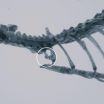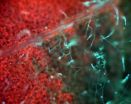(Press-News.org) Researchers at the University of Hawai'i at Mānoa have developed innovative techniques that could have profound effects on congenital cervical vertebrae malformation research.
In the cover-featured research article of the November issue of Molecular Reproduction and Development, researchers looked into congenital cervical vertebrae malformation in humans that can cause neural problems and increase susceptibility to stillbirth in women. Research advancement on abnormal vertebrae development has been limited due to the lack of lab animals with taxonomic equivalency to humans (animal models), and restrictions on human subject research.
Leading the research effort was Dr. Jinzeng Yang, a molecular biologist in the College of Tropical Agriculture and Human Resources' Department of Human Nutrition, Food and Animal Sciences. Researchers from Yang's laboratory have developed a new mouse model that reveals how patterning and developmental proteins can influence cervical vertebrae formation.
The mouse model uses a gene suppression technique that induces skeletal formation. The mice and their offspring appear normal but have striking cervical vertebrae formation. Yang's new gene suppression technique offers benefits, in this case, over the mouse model generated by complete gene removal (knockout mice), which cause mice to die shortly after birth.
Yang's laboratory has been studying myostatin, a protein playing a dominant role in reducing muscle mass. By genetically blocking the function of myostatin by its partial DNA sequences, mice were developed with 40 percent more muscle mass. Yang's graduate student Zicong Li, the first author of the publication, hypothesized that this gene suppression strategy would also work to stimulate skeletal development by inhibiting growth differentiation factor 11 (GDF11), a similar protein to myostatin, and produce live animals. Previously, the mice with complete removal of the GDF11 gene or knockout mice died shortly after birth. In collaboration with Dr. Stefan Moisyadi's laboratory in the UH Institute of Biogenesis Research, they generated the transgenic mice by using a new single plasmid system of piggyBac transgene delivery, which offers greater transposition rates and precision.
INFORMATION:
The original research article is titled, "Transgenic Over-Expression of Growth Differentiation Factor 11 Propeptide in Skeleton Results in Transformation of the Seventh Cervical Vertebra into a Thoracic Vertebra." The publication is available online at http://onlinelibrary.wiley.com/doi/10.1002/mrd.21252/full.
Work was supported by grants from the U.S. Department of Agriculture and the National Institutes of Health.
University of Hawaii at Manoa research focuses on congenital abnormality
2010-12-10
ELSE PRESS RELEASES FROM THIS DATE:
Our brains are wired so we can better hear ourselves speak
2010-12-10
Like the mute button on the TV remote control, our brains filter out unwanted noise so we can focus on what we're listening to. But when it comes to following our own speech, a new brain study from the University of California, Berkeley, shows that instead of one homogeneous mute button, we have a network of volume settings that can selectively silence and amplify the sounds we make and hear.
Neuroscientists from UC Berkeley, UCSF and Johns Hopkins University tracked the electrical signals emitted from the brains of hospitalized epilepsy patients. They discovered that ...
Aromatase inhibitors increased risk of heart disease in postmenopausal women with breast cancer
2010-12-10
SAN ANTONIO — Postmenopausal women who take aromatase inhibitors as a treatment for breast cancer may be at an increased risk for developing cardiovascular disease, according to the results of a meta-analysis.
These data, presented at the 33rd Annual CTRC-AACR San Antonio Breast Cancer Symposium, indicate that women presenting with breast cancer treatment who have risk factors for cardiovascular disease should be considered for a shorter duration of use of aromatase inhibitors.
"It appears that aromatase inhibitors have a significant increase in cardiotoxic side effects, ...
Obese women with ER-positive/HER2-negative breast cancer have poorer survival rates
2010-12-10
SAN ANTONIO — Obesity was associated with worse overall and disease-free survival in women with operable breast cancer treated with adjuvant chemotherapy, but for the first time, researchers observed this finding in only a specific subset of patients – those with estrogen receptor (ER)-positive/HER2-negative disease.
About one third of all adults in the United States are obese, posing a major public health problem because of obesity's association with an increased risk of diabetes and heart disease. This study indentified a new hazard associated with obesity.
Results ...
Most women do not get recommended mammograms
2010-12-10
SAN ANTONIO — Only half of eligible women in the United States are getting their annual mammograms, even if they have insurance to pay for the procedure, according to data presented at the 33rd Annual CTRC-AACR San Antonio Breast Cancer Symposium.
Last year the U.S. Preventive Services Task Force, an independent panel of non-federal experts in prevention and evidence-based medicine, recommended that the age of first mammogram be lifted from 40 to 50 years of age, at which biennial mammography begins, and caused a public outcry. To date, no major insurance company or other ...
Estrogen alone is effective for reducing breast cancer risk
2010-12-10
SAN ANTONIO — While endogenous estrogen (i.e., estrogen produced by ovaries and by other tissues) does have a well-known carcinogenic impact, hormone replacement therapy (HRT) utilizing estrogen alone (the exogenous estrogen) provides a protective effect in reducing breast cancer risk, according to study results presented at the 33rd Annual CTRC-AACR San Antonio Breast Cancer Symposium, held Dec. 8-12.
"Our analysis suggests that, contrary to previous thinking, there is substantial value in bringing HRT with estrogen alone to the guidelines. The data show that for selected ...
Results of AZURE to be presented at the CTRC-AACR San Antonio Breast Cancer Symposium
2010-12-10
SAN ANTONIO — The long-awaited results of the Adjuvant Treatment with Zoledronic Acid in Stage II/III Breast Cancer, the AZURE trial, will be presented at the 33rd Annual CTRC-AACR San Antonio Breast Cancer Symposium, held here Dec. 8-12.
"Adjuvant use of bisphosphonates like zoledronic acid is widespread among women with breast cancer, and the results of this trial will help answer many questions as well invite new ones," said Robert Coleman, M.D., professor of medical oncology at the University of Sheffield in England.
Coleman will present the results of AZURE during ...
Exemestane may be another first-line, adjuvant therapy for hormone-receptor positive, early-stage breast cancer
2010-12-10
SAN ANTONIO — Exemestane, an aromatase inhibitor that blocks production of estrogen, may provide another post-surgery option for postmenopausal women with hormone-receptor positive, early-stage breast cancer.
In the first head-to-head adjuvant clinical trial comparing two aromatase inhibitors, anastrozole and exemestane, the drugs resulted in similar survival rates and prevention of breast cancer recurrences. Some differences in the side effect profile were seen, including a potential difference in the risk of developing osteoporosis.
Paul E. Goss, M.D., Ph.D., professor ...
Genome of barley disease reveals surprises
2010-12-10
Scientists have sequenced the genome of a major fungal disease that affects barley and other cereal crops, a breakthrough that could lead to significant advances in our understanding of how plant diseases evolve. The research, published today in the journal Science, suggests that parasites within the genome of the fungus help the disease to adapt and overcome the plant's defences.
The study could help with the development of new agricultural techniques for protecting cereal crops from infection. Barley grains are the basis of many staple foods, and also central to the ...
The end of planet formation, as told by trace elements from the mantles of Earth, the moon and Mars
2010-12-10
New research reveals that the abundance of so-called highly siderophile, or metal-loving, elements like gold and platinum found in the mantles of Earth, the Moon and Mars were delivered by massive impactors during the final phase of planet formation over 4.5 billion years ago. The predicted sizes of the projectiles, which hit within tens of millions of years of the giant impact that produced our Moon, are consistent with current planet formation models as well as physical evidence such as the size distributions of asteroids and ancient Martian impact scars. They predict ...
Gene hunters tackle crop diseases
2010-12-10
Norwich scientists are on the trail of some of the most economically damaging organisms that infect crops worldwide. Their latest targets are the parasitic water fungus that causes powdery mildew and the water molds that cause late blight in potatoes and tomatoes and downy mildew in cruciferous vegetables and other crops.
"We have been studying the late blight pathogen for a while," said Professor Sophien Kamoun, head of the Sainsbury Laboratory on the Norwich Research Park. "In separate research we are trialling plant genes that mediate blight resistance, while in this ...


